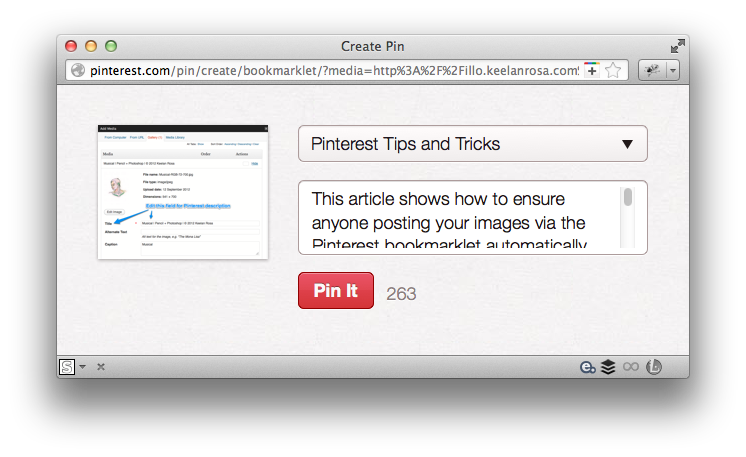I am not the most avid pinner around, but I do use Pinterest, and more relevant to this post I’m one of the artists who doesn’t mind their work ending up on Pinterest – as long as it’s properly credited. Which I figure is a bit more likely if the Pinterest description field is pre-filled and users don’t need to add anything.

There’s three ways to pin (or set things up for other people to pin) images:
- The Pinterest-provided ‘Pin It’ button – Something the webmaster puts on every page individually. I’m not going to use this one myself ever but I did take a look at it and it allows you to pre-fill the description with whatever you want, so in that area it’s pretty good. If you’re going to bother using it you just drop in your credits and you’re good to go.
- Generic social network sharing plugins – Something the webmaster installs which then puts itself on every page automatically. Most of the ones I’ve tried get their description from the post title, which is not the most useful place to put credits as it results in a horde of posts with names ending in stuff like ‘©2012 Artist’ or ‘via My Studio’ – not really great-looking when it’s every post on your blog. Those plugins are great for sites like Twitter, where people need to click a link to get any content, but it’s not really enough for a site where people can view the image without clicking through to see who made the image. The only plugin I’ve found which gets the description from anywhere else is Phil Derksen’s Pinterest “Pin It” Button for WordPress, which seems to basically be a blog-centred version of the Pinterest bookmarklet. Speaking of which…
- The Pinterest bookmarklet – Something the Pinterest user has in their own browser. And now we’re getting into tricky things. Or, actually, non-tricky things which seem tricky, but it took me a bloody hour of trial-and-error to figure this out so I will continue referring to it as ‘tricky’ for quite some time.
When you use the Pinterest bookmarklet (or Derksen’s plugin), the field is already filled in. Not with the page title, either, but if the field is filled in, Pinterest is obviously grabbing the information from somewhere. The question is: where? (A better question is: how do we pre-fill it?)
Neither the Pinterest FAQs nor Google was any help in this regard (which is just odd. You’d think Pinterest would want site owners to be able to better pinnify their sites, and Google is, well, Google), so I did a bit of experimentation (aforementioned bloody hour of trial-and-error) until I discovered the source: the pinned image’s ‘title’ attribution.
This is remarkably easy to change. In many image uploaders, changing the title is a built-in feature:

If you don’t use such an uploader (or prefer doing everything via HTML, or just want a different title than your default, or whatever), the title is still pretty easy to change, as long as you have access to the code you’re working with. For those with no knowledge of HTML: find the place where you can edit HTML, find the bit which says <img src=”yourimage.png”> (there might be some other stuff in there, too, but those are the guaranteed bits), and add title=”your Pinterest description” in between the brackets.

Either way, the end result is a pin automatically showing exactly what you want it to show.

And it’s not limited to just being sure you get proper credit when people pin your images. You can put some pretty long descriptions in the title field.

It takes a wee bit of effort, but no more effort than filling in a description for Pinterest’s Pin It button. Besides, if you run an art-heavy website you should have credits close to all your images anyway, if for no other reason than because plenty of people still think ‘anything on the Internet is public domain’ and may need an obvious reminder of how copyright actually works. And if you’re writing a quick description for the image anyway, it’s no more than a quick copy-paste to increase the odds of the image being properly credited on Pinterest.
random tangent time: why no ‘official’ Pin It button
The problem with the Pinterest-provided button is it’s a page-by-page thing, not a plugin or automatic system, so there’s no way to easily get it on (or, more importantly as far as I’m concerned, off) multiple pages at once. What if Pinterest significantly changes its code in a year, or shuts down completely in two years? Anyone who regularly places the ‘Pin It’ button on their websites will end up with loads of dead code which needs to be removed one page at a time. Noooo thank you. With this method, if Pinterest shutters completely or changes their system so the description is no longer pre-filled from the ‘title’ tag, it won’t have any visible effect on my site. And really, even if I did have the ‘Pin It’ button up, there’s still going to continue to be people for whom the bookmarklet is more natural, so why not put the same description in both places?